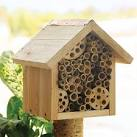 |
| Fall flowers for pollinators |
Give Them Food. Plant many different colors of flowers and different shapes and sizes to increase pollinator diversity. Provide a variety of blooming plants throughout spring to fall. Of particular importance are early spring blooming plants because they provide an immediate food source after the long winter. Plant a variety of annuals, perennials, and flowering trees and shrubs. Late summer and early autumn (end of August through October) are very important periods for the production of adult worker bees that form wintering clusters in their colonies. Click the picture caption for more.
Make a Bee Hotel. Your bee hotel might be as simple as a couple holes in some untreated wood or something more decorative and elaborate. - build one. The bees won’t care what it looks like as long as it’s sheltered from too much sunlight and the elements - mainly moisture. Or leave an area of bare dry soil or a brush pile to encourage ground nesting. It doesn’t have to be unsightly. An area behind a shed or out of the way so it’s not as noticeable will do wonders to attract bees. Just make sure it’s in an area that doesn’t have a lot of human interaction so bees will be encouraged to stay.
Plant Native Species. Plant different flowers, shapes, sizes, colors, and group together in a sunny location. By planting in groups, you’ll provide the nectar all in one easily accessible area. Native plants not only survive more easily than non-native plants, they attract more pollinators.
 |
| Bee Hotel |
Avoid Pesticides. Sometimes we rush to use a chemical as a quick-fix instead of realizing a plant that is stressed needs a diagnosis. Your local extension office can help determine the problem with your plants so bring your sample in, and if detected early there is often a non-chemical solution. If pesticides can’t be avoided, make sure to follow the instructions and apply the right amount during a cooler time of day. Applying more chemicals than instructed won’t help get rid of them faster, but it might result in a chemical drift to other areas and plants you don’t want to be affected. Make sure if you do apply it’s not to flowers or weeds that are already in bloom. Keep in mind, spraying insecticides can cause an outbreak of aphids or spider mites because beneficial insects have been killed. Wise pesticide use is key.
Provide Water Sources. Bees need water to make honey, and other insects besides bees also need water to pollinate. Even if you don’t have a pond or stream, you can hang a dripping bottle or just leave a small container of water in the open for pollinators to drink from. Or, install a bird bath. Keep in mind, bugs can’t get out of a water dish unless there are stepping stones for them to get in and out. Even placing a sponge inside of a dish of water can make it easier. Here's a short video of bees drinking!
